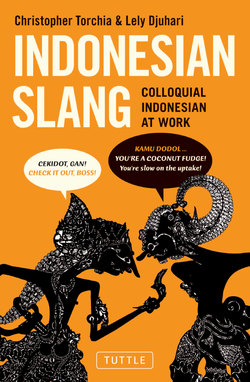Читать книгу Indonesian Slang - Christopher Torchia - Страница 5
На сайте Литреса книга снята с продажи.
ОглавлениеIntroduction
Diam seribu bahasa. Quiet in a thousand languages.
A rough translation might be: The silence is deafening. It evokes barely repressed anger, or the haughty indifference of a beauty with many suitors.
Nongkrong. This is a casual phrase, a reference to the Indonesian custom of hanging out, sometimes by squatting on the roadside.
Mengadu nasib. Tempt fate. Countless Indonesians do this, converging on Jakarta in hopes of finding something better in life. Some succeed, many don’t.
These and other expressions offer one of the best windows onto the Indonesian culture. Slang, titles, proverbs, nicknames, acronyms, quotations and other expressions reveal its character, in the words of its people. This book of expressions looks at Indonesia with the help of its national language, bahasa Indonesia. It describes Indonesians and their fears, beliefs, history and politics, as well as how they live, fight, grieve and laugh.
Indonesian is a variant of Malay, the national language of Malaysia, and many of its expressions come from the Malay heartland of Sumatra island. Indonesian has also incorporated terms from Javanese, the language of the dominant ethnic group in a huge nation of more than 17,000 islands, most of them uninhabited. Hundreds more ethnic groups with their own languages are scattered across the archipelago, and many Indonesians speak bahasa Indonesia as a second language, or mix fragments of it into the local tongue. Still, schools in far-flung regions teach Indonesian, and its role as the language of government and the national media make it a unifying force in one of the world’s most culturally diverse countries. Mindful of that variety, this book offers only a slice of how Indonesians talk.
Although Indonesian is officially a young language, it contains words from Sanskrit, Arabic, Chinese, Dutch, Portuguese and English, a legacy of the merchants, warriors, laborers and holy men who traveled to the archipelago over the centuries.
The Indonesian language was a nationalist symbol during the campaign against Dutch rule in the 20th century. Indonesians who fought against colonialism made it the national language in their constitution when they declared indepen dence in 1945.
Two generations later, modern Indonesians love word play. The tongue slips and skids, chopping words, piling on syllables and flipping them. Indonesians turn phrases into acronyms, and construct double meanings. Their inventions reflect social trends, mock authority, or get a point across in a hurry. Colloquial Indonesian is constantly evolving, and often bears little resemblance to the “correct,” written form of the language, a source of concern to some linguists. Such a divergence is common in languages worldwide, but the vast ethnic mix and breadth of linguistic influences in Indonesia deepens the trend.
Some expressions are easy to match up with idioms from other cultures. Musang berbulu ayam is a civet in chicken’s feathers. In other words, a wolf in sheep’s clothing.
This book divides Indonesian expressions into categories such as food and wisdom, politics and personalities. The format is the same in each chapter. An expression in Indonesian, or sometimes a regional language in Indonesia, is followed by a translation, an interpretation of the meaning, and usually a summary of the idiom’s origin or background. Some translations are more literal than others, reflecting an effort to balance clarity of meaning with the flavor of the original words.
We are grateful to Tantri Yuliandini and Amalia Ahmad for their contributions, and to Sara Datuk and Johanna Wulansari Istanto for their valuable suggestions. Many thanks also go to Mia Amalia, Murizal Hamzah, Prof. Anton Moeliono and Dr. Jan-Michael Bach.
As journalists, we covered a chaotic period in Indonesian history in the late 1990s. The currency plummeted, students protested, riots erupted, and the president resigned, triggering euphoria over the promise of new freedoms and uncertainty over unleashed tensions that often spilled into violence.
Years later, the image of Indonesia as a nation on the brink of collapse has faded. Democracy has taken hold and Indonesia is a place of potential, even if corruption, terrorism and other problems persist. Away from the headlines, bahasa Indonesia tells a different story about Indonesia and its people.
CHRISTOPHER TORCHIA & LELY DJUHARI
